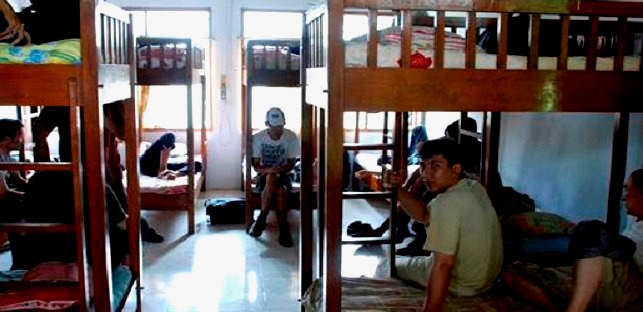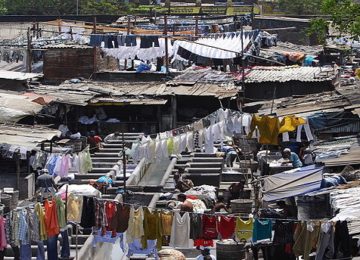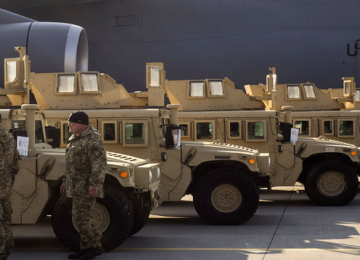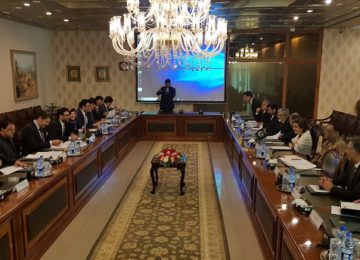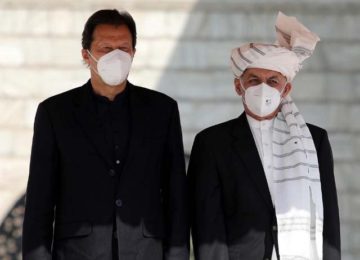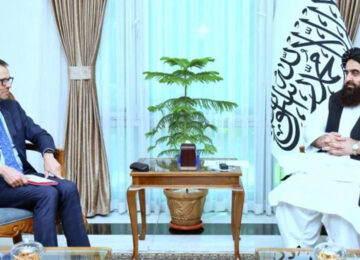Afghan refugees in an Indonesian detention centre have been protesting for over two months. As is the case for most Afghan refugees in the country, they must live in centres scattered across the 16,000 or so islands, although they have been granted refugee status by UNHCR. AAN guest author Amy Pitonak (*) spoke to Afghan refugees at a detention centre in Balikpapan on the island of Borneo. Since mid-January 2018, their demands have included being released, quicker resettlement and better treatment from immigration officials. She describes the conditions in which they live and examines Indonesia’s policy towards refugees.
Since 16 January 2018, a group of 150 refugees – most of them Afghans – have gathered daily in the yard of the Balikpapan Immigration Detention Centre to protest the years they have spent in indefinite detention. Balikpapan’s residents are aged between 14 and 60 and comprise 147 Afghans, two Somalis and one Iranian. All of the Afghan residents are Hazara, an ethnic minority group that has often been targeted by extremist groups for their Shia faith. The refugees are demanding release from detention, quicker resettlement and better treatment from immigration officials.
The protest at Balikpapan is not an isolated event. Afghan refugees and asylum seekers in Indonesia – the world’s fourth most populated country – went on a hunger strike in 2012 at Tanjung Pinang detention centre on Bintan Island between Sumatra and Singapore, as well as in a detention centre on the island of East Nusa Tenggara and in the city of Makassar on Sulawesi island in 2016. Balikpapan is only the latest example of collective action taken by Afghans in Indonesia.
The district of Balikpapan is located in the province of East Kalimantan on the island of Borneo. Tourists come to the province for its white sand beaches, while international companies are drawn by the oil and gas reserves off its coast (see here). The detention centre itself is located near Lamaru Beach, one of Balikpapan’s most popular tourist attractions.
Ehsanullah Sahil is the protestors’ unofficial spokesperson and administrator of their Twitter account through which they document their situation. He told AAN that he had worked as an interpreter with the US Army for three years before threats to his life forced him to flee Afghanistan in 2014. His journey took him first to India, then Malaysia, and finally to Indonesia. After registering with UNHCR in Jakarta he was transported by plane to Balikpapan, where he has been detained since 18 December 2014. In a video interview he describes the conditions of the former prison-turned-immigration detention centre: bars on the windows and doors, high voltage wire surrounding the periphery, men sleeping on mats in overcrowded rooms, and laments “For years we’ve been here, and now we just want to be free.”
The detainees pass their time trying to construct a semblance of normalcy; they bake Afghan naanin the centre’s spacious yet bare kitchen and hang their laundry in neat rows from the bars on its windows. However, Sahil says that most of the detainees are suffering from depression, insomnia or PTSD, and adds that some need surgery for untreated medical conditions. “Everyone is lost mentally.” The centre’s youngest resident, a 14 year-old who has been detained in Balikpapan with his older brother since 2015, adds that there are no activities at all in the centre, emphasising that at the very least, he wants to be able to study.
These are not the ‘economic migrants’ or ‘failed asylum seekers’ that are so often derided in the Western press; all but two of them (one Afghan and an Iranian) have been granted refugee status by UNHCR (more on this below).
However, over the course of their protest many of them relinquished their refugee cards, which are carried by refugees in Indonesia to prevent them from being apprehended by the police for being in the country illegally. One protest organiser explained there was no point in having them while they were being detained.
UNHCR officials have not commented on the protest publicly. However, inside the detention centre, they have informed residents that if they continue their protest, they will not be resettled to a third country or placed in a community house, which is a more comfortable form of accommodation. The use of indefinite detention to punish refugees for participating in a non-violent, peaceful protest goes against UNHCR’s standards. IOM Indonesia have not responded to the author’s queries on this, or indeed for other details, either.
Despite UNHCR and IOM’s stated goal of eliminating the detention of refugees and asylum seekers in Indonesia, the protesting refugees’ spokesman, Sahil, estimates that only 65 refugees have been transferred from Balikpapan to a community centre since 2014. As single men, they are far more likely to be kept in detention than women or families. However, as the presence of a 14 year-old boy at Balikpapan demonstrates, male minors also run the risk of being held indefinitely. UNHCR has voiced its concerns over the regular occurrence of unaccompanied children being detained with unrelated adults in Indonesia, citing instances of abusive behaviour towards minors by prison officials, as well as their lack of access to education (see here).
Afghans in Indonesia and Jakarta’s refugee policy
As of December 2016, Indonesia hosts 14,405 refugees and asylum seekers (see UNHCR’s factsheet here), around half of whom, or 7,154, are Afghans. The majority of them are thought to be Hazara, although there are no definitive statistics on the ethnicity of protection seekers in Indonesia (see this journal article).
Most Afghans come to Indonesia via India or Thailand, often using tourist visas, with the intention of reaching Australia – which has a very restrictive refugee policy, generally preventing newcomers reaching the country’s mainland (see this New York Times Magazine story about Afghan and Iranian migrants crossing the Indian Ocean on their way to Australia). In order to prevent this onward migration, 13 immigration detention centres have been constructed on all the main Indonesian islands, including Java, Sumatra, Kalimantan (Borneo) and Sulawesi, alongside 20 makeshift detention centres. Although Australia does not fund these centres directly, it has funnelled millions of dollars through IOM to provide “care and maintenance” to intercepted irregular migrants, which includes maintaining operations in detention centres (see here and this article on the IOM’s “blue-washing” – ie the use of humanitarian language and branding to mask more controversial projects–of immigrant detention in Indonesia, here). UNHCR has stressed the importance of providing alternatives to detention. To this end, it has helped build 42 community houses based in six of the 34 Indonesian provinces.
Despite the gradual increase in numbers of those seeking protection, Indonesia is not a signatory to the 1951 Geneva Convention or its 1967 protocol. Rather, the Indonesian government insists that Indonesia is only a temporary place for refugees to wait for resettlement. In countries such as Indonesia that are not signatories to the 1951 Geneva Convention, the UN often serves as a substitute for the state in determining the status of refugees. Asylum seekers in Indonesia must register with UNHCR upon arrival, after which they undergo a registration interview and receive an identification card that allows them to stay in the country while awaiting their refugee status determination interview. Those who are recognised as refugees receive a UNHCR refugee ID card, which allows them to stay in Indonesia until they are resettled to a third country. This does not entitle them to additional legal rights or assistance from the Indonesian government, however. As such, they must rely on services provided through IOM or other NGOs.
From 2013 to 2017, 2,387 Afghans were resettled from Indonesia to a third country, with 423 resettlements in 2017. The majority of them went to Australia, followed by the United States. However, since 2014, Australia has not resettled any refugees from Indonesia who arrived after 1 July 2014 (see here).
In December 2016, the Indonesian government passed a presidential decree to better regulate refugee and asylum policies on the islands (see here). In addition to establishing procedures for the rescue of refugees found at sea, the decree also aims to standardise detention facilities and shelters in terms of ensuring that they meet refugees’ basic needs by providing adequate food, clean water, clothing, and access to healthcare and religious facilities. The decree also provides an official definition of a refugee in line with the Geneva Convention’s definition,(1) and formally recognises as refugees and asylum seekers those who have received their status through UNHCR.However, the individual heads of centres and shelters remain in charge of standard operating procedures, and the decree does not include any provisions that address refugee integration (article 26 of the decree stipulates that shelters for refugees should be located in the vicinity of a medical facility and religious faculty, however education facilities and other social services are not mentioned).
Moreover, while the decree mentions ‘temporary shelters’ as alternatives when shelters such as community housing are unavailable, it does not specify what exactly constitutes a ‘temporary shelter’, nor the length of stay. In practice, immigration detention centres appear to function as temporary shelters for refugees awaiting placement in community housing, although the head of Jakarta’s immigration detention centre was quoted in the Jakarta Globes saying “The immigration detention centre is created as a temporary shelter for foreign nationals who break our immigration rules, not to accommodate asylum seekers or refugees” (see here).
Community housing facilities
A little over two-thirds of Indonesia’s total refugee population (4,344 refugees), live outside the detention centres, either independently or in community housing facilities ran by IOM (see UNHCR’s factsheet here). Community houses are required by the 2016 presidential decree to be in the same regency as a detention centre, but the reverse is not always true in practice. For example, Borneo has two detention centres, but there are no community houses on the island (see here for a list of community house locations).
Some refugees in Balikpapan detention centre have stated that community houses are better than detention centres, as they believe that the proximity of community houses to various embassies gives them a better chance at resettlement. Moreover, community houses provide them with food and shelter in a country where they are not allowed to work legally. Refugees who cannot get into a community house are forced to live off remittances from family and friends. Those who do not have the savings to support themselves risk becoming homeless, with some sleeping outside UNHCR offices on cardboard and foam mats. An article by the news website VICE documented the plight of young Hazara refugees who live on Jakarta’s streets at the mercy of mosquitos, heavy rains and older men who proposition them for sex. Many of them resort to self-harm in order to cope with their situation (for more information, please see this article by VICE on homeless Hazara teenagers in Indonesia).
Since each Indonesian island has its own resources and rules governing community housing, conditions in each facility vary. All of the refugees the author spoke to named Jakarta as having the best community housing facilities, with more services and fewer restrictions on refugees’ freedom of movement. Refugees in Jakarta’s community housing are allowed to have visitors in their rooms and can travel outside of the island. They also have access to vocational and language courses provided by IOM.
In Makassar, further east in southern Sulawesi, the arrival of a new head of community housing in early 2018 marked a deterioration in the treatment of refugees living there. They are no longer allowed to have visitors in their rooms. A resident at a community house in Makassar who did not want to be named recounted an incident in February during which a resident who was caught with guests in his room was beaten by security guards, and transferred to a detention centre. Although IOM used to offer vocational and language courses in the city, these programmes were cut in 2017, with only Bahasa Indonesia language courses remaining. Many Afghans at the centre report verbal abuse from staff, who tell them they are ‘like animals’ due to their perceived lack of rights in the country. UNHCR has told residents that they have no control over how refugees are treated at the centre, as this falls under the jurisdiction of the Indonesian immigration authorities. This led to groups of refugees protesting outside the UNHCR office in Makassar to ask for quicker resettlement or better treatment, although both demands have gone unheeded so far.
Refugees in both Makassar and Jakarta have said that access to medical care is subpar. Although they have access to free treatment for serious health problems, they must pay out of pocket for routine illnesses. There is also a lack of mental health treatment in community houses.
Anti-Shia sentiments and Hazara self-organisation
The relationship between Afghan refugees and host communities in the Muslim majority country Indonesia was reported as being positive overall. A community housing resident in Jakarta said that since the centre was far from the city, interactions between locals and refugees were cursory but friendly. An Afghan resident in Makassar reported that the local community was very welcoming at first. However, he says that things have changed since the increase in negative media coverage fuelled by disparaging comments about refugees made by the head of the housing facility on local TV and large signs on the door of the community house identifying it as a ‘detention centre’. As a result, he says that local people in Makassar have begun to think of Afghans as criminals, and avoid them.
Although the refugees’ relations with their host community are generally peaceful, this peace is maintained on the basis that the Hazara keep their religious practices to themselves. Hazara refugees cannot freely practice Shia religious ceremonies such as Muharram for fear of reprisals from the majority-Sunni host community.
This anti-Shia sentiment has been exacerbated by the National Anti-Shia Alliance (ANNAS), a group made up of various Indonesian fundamentalist groups such as the Majelis Mujahidin and the Council of Islamic Dawah Indonesia. In Makassar, ANNAS has hung banners proclaiming “Shiism is not Islam” and distributing pamphlets accusing the Shia of spreading homosexuality and perversion. The refugees in Balikpapan detention centre also suspect that ANNAS’s activities have contributed to their lengthy detention. After one of the group’s affiliates spread a rumour that the residents of Balikpapan had been brought there by international organizations in order to ‘slaughter Sunni Indonesians’, some IOM staff told the Hazara residents in Balikpapan that they were being kept in the centre because locals do not want them in the community.
This need for secrecy has caused Indonesia’s community of Hazara refugees to withdraw into itself, creating intense solidarity between community members as well as bolstering relative isolation from locals (see this journal article here). Members of Indonesia’s small native Shia population – approximately 1.2 million out of a population of 261.1 million – also try to be as inconspicuous as possible. A Hazara refugee in Makassar said that even local Shia are afraid of openly practicing their faith, while a Hazara in Jakarta said the province’s only Shia mosque was too far away for refugees to access.
Instead, over 3,000 Hazara have congregated around the Puncak Pass in West Java, an area known for its clean air and sprawling greenery, where they have developed a wide range of initiatives to improve their situation. One prominent example is the Cisarua Refugee Learning Centre, a school founded by Hazara refugees that functions as a school for the area’s children while offering English classes and extracurricular activities for adults. Positive representations of the Hazara have also begun to appear in Indonesian society, such as a photo exhibition entitled “Living in Transit: Refugee life through the Eyes of the Afghan Hazara Community” hosted at the University of Indonesia.
IOM’s voluntary return programme
UNHCR cites three “durable solutions” available to refugees in Indonesia: resettlement to a third country, integration into the host community, or voluntary repatriation. The likelihood of the first solution is slim; the resettlement rate for Afghans in Indonesia is between three and five hundred per year since 2014 (see here). UNHCR warns that many refugees in Indonesia may never be resettled (see here). However, many Afghans in Indonesia are not satisfied with the remaining two options, citing the lack of integration opportunities available to them and a fear of returning to their home country.
While UNHCR and IOM present the Assisted Voluntary Return and Reintegration programme as an alternative to detention, it is doubtful whether any decision to return made in this context can be truly voluntary. IOM claims that this programme helps migrants return safely to their country of origin, but it is hard to imagine a safe return for at-risk minority groups such as the Hazara. As well as being fully informed and not physically coerced, having at least one option that ensures a reasonable level of welfare is an important aspect of a voluntary decision (see this study, pp 631-45). For Afghans kept in indefinite detention in Indonesia, none of the options presented to them provide a level of welfare that would generally be considered as acceptable.
According to IOM Afghanistan figures, 1,478 Afghans returned from Indonesia via the AVRR programme between 2003 and 2016. By August 2017, IOM had registered 58 voluntary returns from Indonesia for that year. In the case of Balikpapan, Sahil recounts the pressure that centre residents face from a return to Afghanistan, stating that when they complain about their detention, IOM employees tell them “The resettlement process is too long. If you can’t endure it, you can go back to your country.” Both Sahil and another centre resident said that since 2014, 44 detainees in Balikpapan have accepted this offer. One returnee said that he would try to flee Afghanistan again as soon as he had enough money, this time to Iran or Pakistan.
Other residents, when faced with a choice between detention and return, attempt to create their own alternatives. In 2017, five Afghans escaped from Balikpapan by using bed sheets to climb the six-metre high wall surrounding the enclosure and jumping past the high voltage and barbed wire to freedom (see here). A sixth man broke his leg during the attempt. Some committed suicide; a media report counted at least six such cases since 2016), at least two of which were Afghans. The most recent case was that of a young Hazara refugee in Medan, Sumatra who killed himself after a lengthy period of detention (see here).
Migration scholars have argued that the ‘voluntary return’ of rejected asylum seekers could be better described as ‘soft deportation’. (2) If so, the return of recognised refugees forced to choose between detention and a return to danger or persecution may be, in reality, no more than a mild form of refoulement (3), as this goes against international refugee law. Although the original cause of this situation is Indonesia not being a party to the 1951 Geneva Convention, IOM and UNHCR should not tacitly facilitate the host government’s violation of one of the Convention’s most basic tenets.
The refugees in Balikpapan say that a choice between return and detention is not a choice at all. Instead, they say they will continue their protest until they can gain, if not resettlement, at least their freedom.
* Amy Pitonak is a research fellow with Bosphorus Migration Studies, an independent think tank based in Istanbul, Turkey.
(1) According to the 1951 Geneva Convention, a refugee is someone who has a ‘well-founded fear of persecution due to race, ethnicity, religion, nationality, membership of a particular social group, and different political opinions, and does not wish to avail him/herself of protection from their country of origin’.
(2) Leerkes, A., van Os, R., and Boersema, E. (2017) What drives ‘soft deportation’? Understanding the rise in Assisted Voluntary Return among rejected asylum seekers in the Netherlands. Population, Space, and Place, 23.8. (See here.)
(2) Refoulementis the forcible return of refugees or asylum seekers to a country where they are liable to be subjected to persecution.
By Special Arrangement with AAN. Original link.
Disclaimer: Views expressed on this blog are not necessarily endorsed or supported by the Center for Research and Security Studies, Islamabad.



